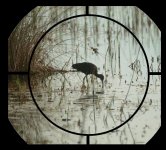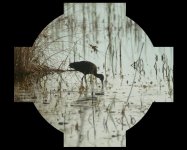looksharp65
Well-known member

I'm a perception guy.
So am I, Ed. :-O
I'm not sure there's an abyss between our understandings. We may only put different emphasis on some things, then misinterpret how much emphasis the other guy puts in things. And remember I said I may be wrong.Needless to say there is quite a distance between our understanding of things.
Anyway, I'll try to explain my line of thinking.
Focusing an optical image over the retina is one thing, and having the neural apparatus to resolve fine detail in a particular retinal area is another.
Yes, and hopefully you've noticed that I mentioned the two central degrees of sharpness. See also the diagram on the distribution of visual acuity:
http://en.wikipedia.org/wiki/Fovea_centralis
What I'm saying is that the optics of the eye are far from perfect, so even if we did have a greater portion of the retina literally packed with cones, the aberrations of the eye would be the limiting factor for our visual acuity.
Of course, more so the further into the periphery of the retina we go.
Undeniably, we're able to detect peripheral zones [periphery of the retina, that is] of decreased sharpness when looking through a poor telescope. Partially this is due to the movements of the eye, but also that the brain detects when there are other aberrations than what it is used to see.
During the first year in life, visual acuity increases very much. And the brain learns how the physical world relates to the retinal image.
This experience is the foundation to the amazing correctness by which most of us can assess the surroundings. Despite the vast optical aberrations and the low density of cones in the periphery of retina, the brain is able to compute the cues received from the eye.
Thus, the peripheral acuity and judgement of object's size and location are greater than could be expected from the anatomical organization of the eye.
But why on earth would the sun "boil the [peripheral] retina in seconds" if images were focused there but not at the fovea? I take it you actually believe this to be true — with or without glasses. Good grief!
Staring at the Sun for more than a fraction of a second will cause permanent and severe damage to the fovea. The small, focused image of it literally boils the retina. Not staring at the Sun is a reflexive behavior aided by the painful muscle contraction of the pupil.
But somewhere beneath the Sun, let's say 15 to 30 degrees off-center, we can keep the fixation, at least with some strain.
I still believe that if the peripheral parts of the retina had a focused image of the Sun when doing this, it would cause severe burning just like when looking directly at it.
But if the image of the Sun is greatly distorted by optical aberrations at oblique sight angles, its greater areal extension and its oblique projection on the retina will mean greater distribution of the intense light energy, resulting in less danger of retinal damage.
The eye's aberrations are so vast that it's more or less a miracle that we see so good that we actually do. It has been shown more than 200 years ago that the eye has a lateral astigmatism.
http://www.arkiv.certec.lth.se/dok/optikforsynsvaga/bilagor.pdf
http://www.telescope-optics.net/eye_aberrations.htm
Cheers!
//L
Last edited:







